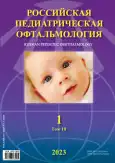Ophthalmological follow-up of premature children in St. Petersburg
- Authors: Saidasheva E.I.1,2, Malinovskaya N.A.1
-
Affiliations:
- North-Western State Medical University named after I.I. Mechnikov
- Children’s city multidisciplinary clinical specialized center for high medical technologies
- Issue: Vol 18, No 1 (2023)
- Pages: 47-52
- Section: Technical report
- URL: https://journals.rcsi.science/1993-1859/article/view/131782
- DOI: https://doi.org/10.17816/rpoj177627
- ID: 131782
Cite item
Abstract
Premature newborns have a high risk of developing visual impairments. This study presents the experience of an organization dispensary ophthalmological observation as a stage of providing medical care to premature children in St. Petersburg and the prospects for its development.
AIM: To analyze the effectiveness of the organizational model of dispensary ophthalmological observation of premature children in St. Petersburg for 2020–2022.
MATERIAL AND METHODS: Reporting forms of the activities of interdistrict ophthalmological cabinet and reporting forms of medical and social expertise of Rosstat No. 7D were used.
RESULTS: In 2010, a system of specialized ophthalmological care for premature infants at the hospital stage was organized in St. Petersburg (screening and laser treatment of active ROP using telemedicine technologies; surgical treatment of late disease stages). In 2018, for the subsequent dispensary observation of premature children aged up to 3 years, six inter-district ophthalmological cabinets of follow-up were organized. A developed routing scheme for children at risk and with active and cicatricial ROP in St. Petersburg and preliminary results of ROP incidence were presented.
CONCLUSION: The activities of specialized inter-district follow-up cabinets primarily ensure continuity between hospital and outpatient services in the dynamic monitoring of children at risk and children with active ROP. In addition, professional competencies allow ophthalmologists to avoid mistakes in diagnosing the stage, monitoring the ROP course, and promptly referring patients for emergency treatment (laser or anti-VEGF therapy).
Full Text
##article.viewOnOriginalSite##About the authors
Elvira I. Saidasheva
North-Western State Medical University named after I.I. Mechnikov; Children’s city multidisciplinary clinical specialized center for high medical technologies
Author for correspondence.
Email: esaidasheva@mail.ru
ORCID iD: 0000-0003-4012-7324
SPIN-code: 7800-3264
MD, Dr. Sci. (Med)
Russian Federation, Saint Petersburg; Saint PetersburgNatalya A. Malinovskaya
North-Western State Medical University named after I.I. Mechnikov
Email: benimor100@mail.ru
ORCID iD: 0000-0002-4560-6239
SPIN-code: 8306-9359
MD, Cand. Sci. (Med.)
Russian Federation, Saint PetersburgReferences
- Neroev VV, Katargina LA, Kogoleva LV. The prevention of blindness and visual impairment in children with retinopathy of prematurity. Current pediatrics. 2015;14(2):265–270. (In Russ). doi: 10.15690/vsp.v14i2.1296
- Kogoleva LV, Katargina LA. The factors responsible for impairment of vision and the algorithm for the regular medical check-up of the patients following retinopathy of prematurity. Russian Pediatric Ophthalmology. 2016;11(2):770–777. (In Russ). doi: 10.18821/1993-1859-2016-11-2-70-76
- Sakharova YeS, Keshishyan YeS, Alyamovskaya GA. Premature birth as a medical social problem. Part 3. Methods of premature infants follow-up. Russian Bulletin of Perinatology and Pediatrics. 2017;62(5):43–48. (In Russ). doi: 10.21508/1027-4065-2017-62-5-43-48
- Simakhodsky AS, Sevastianova LD, Gorelik UV, Lukashova UV. Medical and social aspects of disabilty development in children of yonger age groups Saint Petersburg during 2008–2017. Preventive and Clinical Medicine. 2019;3(72):27–32. (In Russ).
- Saidasheva EI, Fomina NV, Baranov AV, Korlyakova MN. The principles of organization of ophthalmological care in Sankt-Peterburg. Russian Pediatric Ophthalmology. 2012;2:39–43. (In Russ).
- Saidasheva EI, Buynovskaya SV, Alekseev YuA. et al. Ophthalmological examination of premature children in Saint-Petersburg: results and prospects. Preventive and Clinical Medicine. 2021;1(78):53–57. (In Russ) doi: 10.47843/2074-9120_2021_1_53
- Saidasheva EI, Plotnikova EV, Bilichenko SV, Shilina VI. Organizational models of ophthalmic observation of premature children in pediatric follow-up. Russian Ophthalmological Journal. 2022;15(4):84–88. (In Russ). doi: 10.21516/2072-0076-2022-15-4-84-88
- Gursoy H, Basmak H, Bilgin B, et al. The effects of mild-to-severe retinopathy of prematurity of the development of refractive errors and strabismus. Strabismus. 2014;22(2):68–73. doi: 10.3109/09273972.2014.904899
- Moskowitz A, Hansen R, Fulton A. Retinal, visual and refractive development in retinopathy of prematurity. Eye Brain. 2016;8:103–111. doi: 10.2147/EB.S95021
- Chiang MF, Quinn GE, Fielder AR, et al. International Classification of Retinopathy of Prematurity, 3rd edition. Ophthalmology. 2021;128(10):e51–e68. doi: 10.1016/j.ophtha.2021.05.031
- Мintz-Hittner HA, Geloneck MM, Chuang AZ. Clinical management of recurrent retinopathy of prematurity following intravitreal bevacizumab monotherapy. Ophthalmology. 2016;123(9):1845–1855. doi: 10.1016/j.ophtha.2016.04.028
Supplementary files






